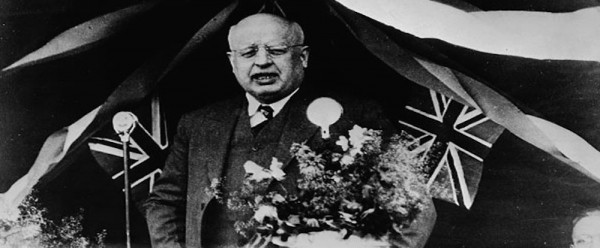The Alberta Social Credit Party is no more. Taken over by a group of anti-abortion activists in 2016, the party has officially changed its name to the Alberta Pro-Life Political Association. According to Elections Alberta, the name change became official on May 3, 2017.
While the Social Credit Party has sat on the conservative fringe of Alberta politics for much of the past four decades, the party fundamentally reshaped the politics of our province when it formed government from 1935 to 1971.
Inspired by the Social Credit teachings of British Major CH Douglas, William Aberhart‘s Social Credit Party swept the 1935 Alberta election in a populist wave, going from zero to 56 seats during the height of the Great Depression.
Upon learning of the election victory in 1935, the Social Credit Greenshirts in London were reported to have marched around the Bank of England Building holding torches and blowing their trumpets – no doubt inspired by the Battle of Jericho. (this was a period in western history when it was not uncommon for political parties to have official uniforms).
During its first decade in government, Aberhart’s radical administration tried to print its own currency, legislate control over the media, nationalize the banking system and ban alcohol sales. The Social Credit Party also introduced the province’s short-lived MLA recall law and a provincial sales tax.
In response to what they claimed to be a “world plot” by “socialists and world finance” (which is coded language for Jewish) the Alberta government-funded Social Credit Board proposed in 1947 that the secret ballot and political parties be abolished. “The obvious remedy for the evils of party politics is the abolition of political parties dominated at the top as we know them today,” the report argued.
Ernest Manning abolished the Social Credit Board in 1948.
It really was a bizarre time in Alberta politics.
Under Manning’s leadership from 1943 to 1968, the Social Credit Party evolved into a generic conservative governing party, albeit with a social conservative bent.
Perhaps the most important lasting legacy of the Social Credit government today is the continued existence of the Alberta Treasury Branches, which was founded in 1938 after the federal government thwarted attempts by Aberhart to impose government control over banks operating in Alberta.
The party was defeated in 1971 and last elected an MLA to the Legislature in 1979. Leader Randy Thorsteinson, led the party to win 6.8 percent of the vote in the 1997 election and later formed the Alberta Alliance Party (which later became the Wildrose Party). He is now the leader of the Reform Party of Alberta.
The Social Credit Party ran six candidates in the 2015 election, earning a total 832 votes.

